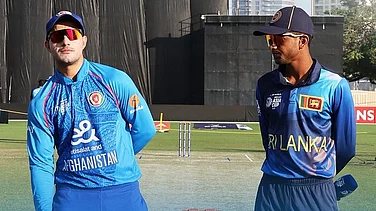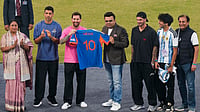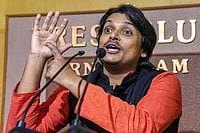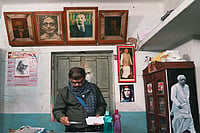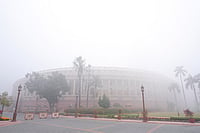How many matches of this World Cup do you recall? Yes, the New Zealand-South Africa semi-final. Next? Perhaps the low-scoring Australia-New Zealand league match (which the Kiwis should have finished in a flash but made a mess of). The third game? You will have to think hard to come up with it. Why was the World Cup so tame? Here are four reasons:

New bats Afghanistan’s Shafiqullah hoists one against England
Format: Non-Matches
There has to be something wrong with the format if in the qualifying rounds, out of the 42 games, only 16 are played between old cricketing nations—India, Australia, South Africa, New Zealand, Sri Lanka, Pakistan, England and Bangladesh. Sure, the minnows have to be given a chance on the world stage, but shouldn’t the whole thing be inverted? The lesser teams get knocked out if they lose a couple of games in the beginning of the tournament, and the cricketing nations play off each other more? Four of these eight never faced each other! The present format will work in the soccer world cup, where so many countries are so good, and upsets can happen at any stage. With so few cricket-playing countries, the World Cup has to have more games between them. It’s perhaps time to think of a round-robin format between them before the quarter-final stage.

None higher Martin Guptill after his 237 n.o. versus the Windies. (Photograph by Reuters, From Outlook 13 April 2015)
High Scores: Too High?
All of us, except the chronically young, remember a time when ODI batting was a compound of varying genres of skills—Test-style grit, cussedness and solidity blended with flair, athleticism and calculated bursts of big artillery. A time when a first innings score of 183 could make for a tense, lip-smacking World Cup final. And “low-scoring thriller” was a respectable genre in itself. For all the flashing blades of those days, the favourite cliche was “stealing a cheeky single”, not “racing like a tracer bullet”.
The 1992-1996 Cups inaugurated the more steroidal phase, formalising the role of the pinch-hitter. Yet, these were meant to be thrilling exceptions, a booster shot of adrenaline administered into the veins of a more dependable, classical line-up. But that derring-do slowly became the norm. Graphite-induced bats, field restrictions and the rest gave us a time when higher peaks could be occasionally sighted.
And now? A decade of T20 slambang has altered the grammar of ODI batting almost beyond recognition. We had 27 out of 96 World Cup innings—well over quarter—breezing past what was once odi’s version of the 4-minute mile, that is, a 300+ score. As many as 15 of them breasted the tape, scarcely out of breath, at the 330+ end of the spectrum. Yes, and that includes three 400+ scores. That either means games lost before the chase. Or extended IPL style thrillathons...more sixes in a World Cup than there are sheep in New Zealand. Is there such a thing as too much satiety? Counting sixes, counting sheep...yawn.

Old hats Steve Smith exults after the win in the final at MCG. (Photograph by Reuters, From Outlook 13 April 2015)
One-Sided Games
Of the seven games in the knockout stage, three were won by runs of 95, 109 and 143. Three more were won by 6, 7, and 9 wickets. In the qualifying rounds, it was even worse. Eleven games were won with 6 or more wickets (three of these were won with 9 wickets). Twelve were won with a margin of more than 100 runs (of these three had a victory margin of over 200 runs). Well, the organisers can’t help it if teams give up too soon, but the reason for one-sided games can be many—opponents whose lack of parity sometimes begins to override thoughts of cricket democracy, stolid pitches, run-feasts. The ICC can mull over what is to be done to make a Cup worthy of the name.

Those days Sachin lifts Warne at the ’96 World Cup in Mumbai
The Missing Greats
One-day teams practically invented the almost sub-par but serviceable cricketer, the bits-and-pieces guy who comes in and bowls a tight, drone-like spell, lets go a few well-timed slashes past gully at crunch moments, and runs like a hare between the wickets. Think Chris Harris or Robin Singh. But scan your eyes over the last quarter century and you see the jack-of-all-trades figure was like packing material that held together an assemblage of greats. Look at any lineup of past World Cups. They oozed class. Teams fairly rippled with all-time greats of the game like McGrath, Lara, Kallis, Pietersen, Tendulkar, Muralitharan, Warne, Imran, Donald, Dravid, Akram, Ponting. You also had great grenadiers, the Haydens, Sehwags, and Shoaib Akhtars, mean spin meisters, and some of the best field marshals ever in Steve Waugh and Ganguly. Further back, you catch glimpses of godly apparitions like Viv Richards, Kapil Dev, Ian Botham. Match that against WC 15 and what you see, not to put too fine a point on it, is a poverty of greatness. Look for names who could stake claim to God’s All-Stars XI...and it’s a thin yield. The crackerjack A.B. de Villiers for sure; the silken samurai duo from Lanka, Sanga and Mahela; the sonic boom of Gayle. Yes, there were moments of brilliance...Wahab Riaz sending 150 kmph snorters past an ageing Watson’s nose, for instance. But set that against a tense Sachin contest against McGrath or Shoaib—in terms of sheer nomenclatural heft—and you know 2015 was the minor league.












